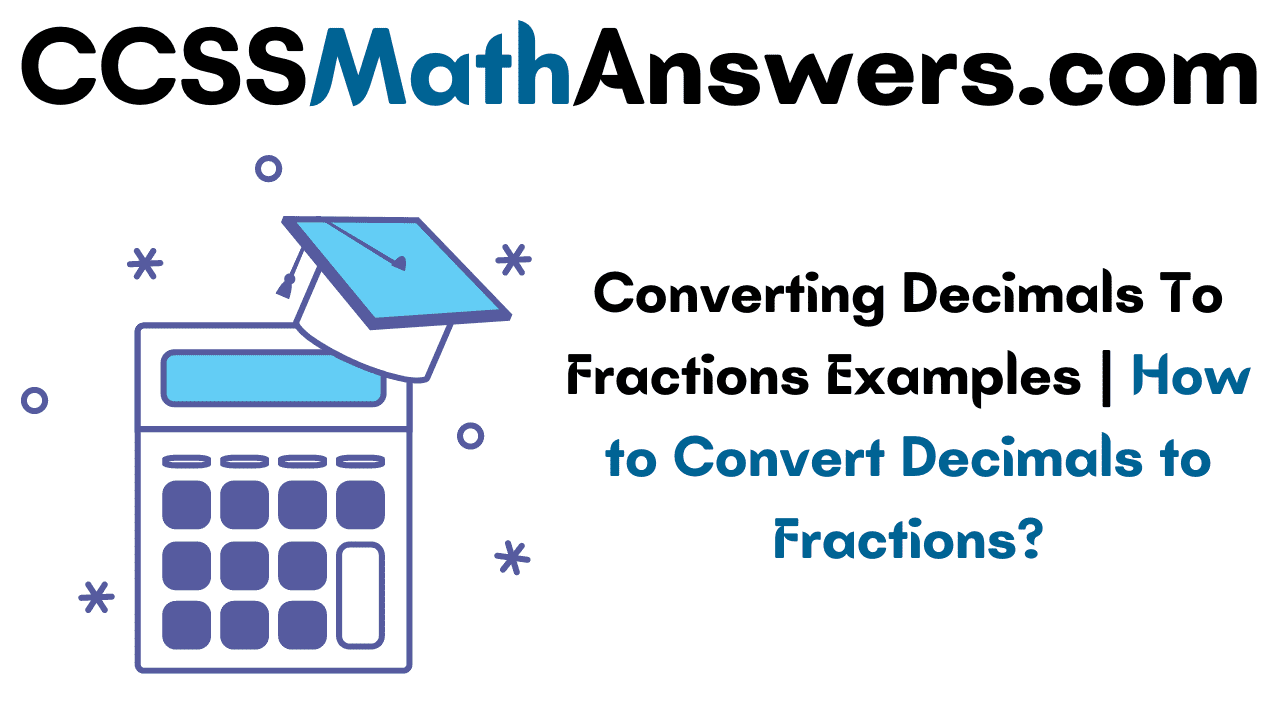Are you looking for ways on how to convert from decimals to fractions? Then, look no further as we have listed the easy ways to convert from decimal to fraction in a detailed way here. Before doing so you need to understand firstly what is meant by a decimal and fractions. Refer to the entire article to know about the procedure on how to convert a decimal to a fraction along with solved examples.
What is meant by a Decimal?
A Decimal Number is a number that has a dot between the digits. In other words, we can say that decimals are nothing but fractions with denominators as 10 or multiples of 10.
Examples: 4. 35, 3.57, 6.28, etc.
What is meant by Fraction?
A fraction is a part of the whole number and is expressed as the ratio of two numbers. Let us consider two numbers a, b and the fraction is the ratio of these two numbers i.e. \(\frac { a }{ b } \) where b≠0. Here a is called the numerator and b is called the denominator. We can perform different arithmetic operations on fractions similar to numbers. There are different types of fractions namely Proper, Improper, Mixed Fractions, etc.
How to Convert Decimal to Fractions?
Follow the simple steps listed below to convert from decimal to fraction and they are as such
- Firstly, obtain the decimal and write down the decimal value divided by 1 i.e. \(\frac { decimal }{ 1 } \)
- Later, Multiply both the numerator and denominator with 10 to the power of the number of digits next to the decimal point. For else, if there are two digits after the decimal point then multiply the numerator and denominator with 100.
- Simplify or Reduce the Fraction to Lowest Terms possible.
Solved Examples on Decimal to Fraction Conversion
1. Convert 0.725 to Fraction?
Solution:
Step 1: Obtain the Decimal and write the down the decimal value divided by 1 i.e. \(\frac { 0.725 }{ 1 } \)
Step 2: Count the number of decimal places next to decimal point. Since there are three digits multiply both the numerator and denominator with 103 i.e. we get \(\frac { 725 }{ 1000 } \)
Step 3: Reduce the Fraction to the Lowest Terms by dividing with GCF. GCF(725, 1000) is 25. Dividing with GCF we have the equation as follows
= \(\frac { (725÷25) }{ 1000÷25 } \)
= \(\frac { 29 }{ 40 } \)
Therefore, 0.725 converted to fraction is \(\frac { 29 }{ 40 } \)
2. Convert 0.15 to fraction?
Solution:
Step 1: Obtain the decimal and write the decimal value divided by 1 i.e. \(\frac { 0.15 }{ 1 } \)
Step 2: Count the number of decimal places next to the decimal point. Since there are two digits multiply both the numerator and denominator with 102 i.e. we get \(\frac { 15 }{ 100 } \)
Step 3: Simplify the Fraction Obtained to Lowest Terms if possible by dividing with GCF.
We know GCF(15, 100) = 5
Dividing with GCF we get the equation as follows
= \(\frac { (15÷5) }{ 100÷5 } \)
= \(\frac { 3 }{ 20 } \)
Therefore, 0.15 converted to fraction is \(\frac { 3 }{ 20 } \)
FAQs on Converting Decimals to Fractions
1. What is a Decimal?
A Decimal Number is a Number whose Whole Number Part and Fractional Part are separated by a decimal point.
2. How to Convert a Decimal to Fraction?
We can convert Decimal to Fraction by placing the given number without considering decimal point as the numerator and denominator 1 followed by a number of zeros next to the decimal value. Later, reduce the fraction obtained to the lowest terms to obtain the resultant fraction form.
3. What is 0.62 as a Fraction?
0.62 in Fraction Form is obtained by dividing numerator with denominator 10 to the power of the number of zeros next to decimal point i.e. \(\frac { 62 }{ 100 } \). Simplify the fraction to the lowest terms. Thus, we get the fraction form as \(\frac { 31 }{ 50 } \)
